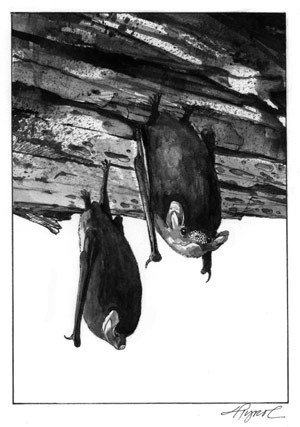
Ryan Smith, a wildlife technician with the Vermont Fish and Wildlife Department, stood with his back to the mouth of the Mount Aeolus bat cave in Dorset, Vermont, in early April. Behind him, icicles rose from the ground like stalagmites. He wore a white Tyvek biohazard suit with the hood up. The respirator with hot-pink filter caps blocked the smell of dead bats wafting up from the cave.
In Smith’s hands was a little brown bat. He turned it on its back to determine its sex and spread its wings to look for the tell-tale white fungus. He found it. “Male myo,” he said, referring to the scientific name for the little brown bat, Myotis lucifugus. “Fungus on nose.”
This bat weighed 5.8 grams. According to wildlife biologist Scott Darling, also of Vermont Fish and Wildlife, the average weight of a little brown bat emerging from hibernation, as this one was, is seven grams. A weight below six grams, Darling warned, is the point of no return for a little brown bat.
A mysterious malady has been killing bats by the thousands in New York and Vermont. Bats with the disease have also been found in Massachusetts, Connecticut, and possibly Pennsylvania. (No sick bats have been found to date in New Hampshire caves.) The most obvious symptom is a white fungus growing around the nose of the infected bats, giving it the name “white-nose syndrome.”
While a dozen laboratories across the country are busy investigating the cause of the syndrome, little is yet known. The white fungus, which can be found anywhere on the bat’s body and isn’t always present on sick bats, wasn’t thought to be the cause at first, but rather a symptom. The latest thinking is that the fungus may in fact be playing a causative role.
What all the sick and dying bats do seem to have in common is that they are starving to death. They weigh less than a typical bat would, and many have no body fat, a necessity for hibernation.
Last winter, some bats with the syndrome left their hibernation caves in mid-winter, sometimes at midday. Others roused from hibernation and flew off much earlier in spring than is typical, leaving their caves before there were enough flying insects to feed on.
The first sick bats were discovered in caves near Albany, New York, in the winter of 2006-2007. In these caves, the living bats huddled closer to the cave entrances, where temperatures are colder than is typical deeper in the cave. The bodies of dead bats littered the floor nearby. In one cave, 100 percent of the hibernating bats were dead by this spring.
This past winter, white-nose syndrome was discovered in Morris Cave in Danby, Vermont, in January, and at the Mount Aeolus Cave in Dorset, Vermont – a major wintering location for bats all across New England – in February. The syndrome was found in the eastern part of the state, at the Elizabeth Mine in Strafford, in April.
Of the six species of bats that over-winter in caves in Vermont and New Hampshire, several species have been seen with the syndrome, including the federally endangered Indiana bat. Little brown bats, such as the one found by Ryan Smith at Mount Aeolus, seem particularly hard hit.
The big brown bat (Eptesicus fuscus), one of the most common bats in our area (and one of the two species, along with the little brown bat, most likely to appear inside someone’s home) does not seem to be affected by the syndrome.
In all, scientists estimate that half a million bats will eventually be killed in the caves affected so far. Those bats would have eaten billions of insects over the course of a summer. Darling says that, while much has been made of the potential upsurge in mosquitoes because of the bat decline, it’s the moths and beetles that are most likely to see population gains, since they make up a higher percentage of bat diets overall than mosquitoes do.
Last year, it was the mysterious deaths of bees that made headlines. This year, it’s bats. Could the two be related? Not directly, says Darling. Bees fly only during the day, and bats eat at night; it’s not that the bats ate the sick bees and got sick themselves. So far, the evidence shows that that humans don’t get sick from the bat syndrome. Darling and his team wore hazmat suits on Mount Aeolus mostly to protect the bats.
What the longer-term effect of the syndrome will be is almost as mysterious as its causes. In a public presentation in Manchester, near the Aeolus cave, Darling said, “The question is, are we are living in an ecological experiment where we find out what was the role that bats played in our ecosystem?”

